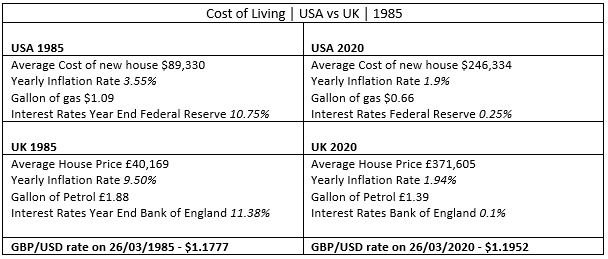With plenty of volatility and concerns for businesses and just about everyone across the globe, the pound tumbled to $1.15 last week, its lowest level since 1985 and below the point it tumbled to during Brexit. But why has GBP been hit so hard in times of crisis, when the rest of the world is also suffering from Coronavirus? Wouldn’t other currencies experience the same levels of volatility?
Well, not exactly. It’s largely due to investors protecting their funds. In challenging times, investors often return to what is know as “safe haven currency” and Dollar is king of the safe havens. It was only a matter of time before we would see many converting sterling to dollar, as we have this week.
With the forex charts for GBP/USD resembling more the golden arches of McDonalds, we thought we would take a look back to 1985, the last time we saw GBP/USD tumble as low as $1.15. To Understand what happened in 1985 we need to look at what was happening then.
So, what were the major headlines in 1985?
Coca-Cola Company introduces New Coke, Heysel Stadium Disaster, Unabomber kills his first victim, CD’s Introduced, Wreck of the RMS Titanic Located, Mexico City Earthquake kills 9,000, Greenpeace ship Rainbow Warrior is sunk by French Agents, As the spread of aids increased Governments round the world start screening Blood donations for AIDS. On the technology front, the first “.com” is registered and the first version of Windows is released V1.0, Terrorists continue to perform acts of terrorism including the hijack of TWA Flight 847 and the Italian Cruise Liner “Achille Lauro “. Famine in Ethiopia is shown more on the news and Live Aid concerts around the world raise many millions to help the starving in Africa .
So, it’s fair to say a lot happened in 1985, only its Coronavirus not Aids, it’s wild fires not earthquakes, it’s Greta Thunberg and not BandAid. But, how does 1985 stack up against 2020, when looking at some basic statistics?

So, inflation and interest rates have plummeted since 1985 as well as the average cost of petrol, but house prices have continued to climb across both ends of the pond. Very likely, why land banking has become another safe haven for investors over the years, but back in February 1985, GBP/USD slid to it’s lowest low $1.05. Unlike today however, it was less a story of pound weakness and more to do with an extremely strong dollar.
This was due to the combination of Ronald Reagan as US president and the tenure of Paul Volcker as chairman of the Federal Reserve, while seeing the dollar appreciate 26% between 1980 and 1984.So, Inflation and interest rates have plummeted since 1985 as well as the average cost of petrol, but house prices have continued to climb across both ends of the pond. Very likely, why land banking has become another safe haven for investors over the years, but back in February 1985, GBP/USD slid to it’s lowest low $1.05. Unlike today however, it was less a story of pound weakness and more to do with an extremely strong dollar.
President Reagan instituted a series of tax cuts and spending rises in an attempt to revive the economy. This in turn pushed up long-term interest rates, attracting inflows of capital and pushing up the value of the dollar.
Despite the pressure of the strong dollar, the UK economy was performing well at the time with economic growth of 2.3% in 1984 and 4.2% in 1985.
The strength of USD created international tension which was addressed in an unprecedented meeting of world leaders and central bankers at the Plaza Hotel in New York in September 1985.
The central bankers agreed that other currencies should appreciate against the dollar and followed their words with interventions in foreign exchange markets, selling dollars in exchange for other currencies.
The actions of those involved in the so-called “Plaza Accord” contributed to the dollar falling 40% between 1985 and 1987.
The pound gained ground on the dollar in the months that followed, hitting $1.88 in December 1987.
As history has shown Sterling will make the climb once again to be a strong currency against major currencies, but now is a very good time to consider how your business is trading internationally.
What protection methods have you got in place to ensure currency fluctuations doesn’t eat away at your profit margins?
Call our team today to conduct a free Currency Risk Assessment and find out what hedging strategies can help you guide your business through these difficult times, protect your bottom line and ensure you’re not left wide open to the volatilities of the expected market movements to come.
To book your free Currency Risk Assessment, please call: +44 (0) 207 265 7979
Or email: <BookMyCRA@centralfx.com>






